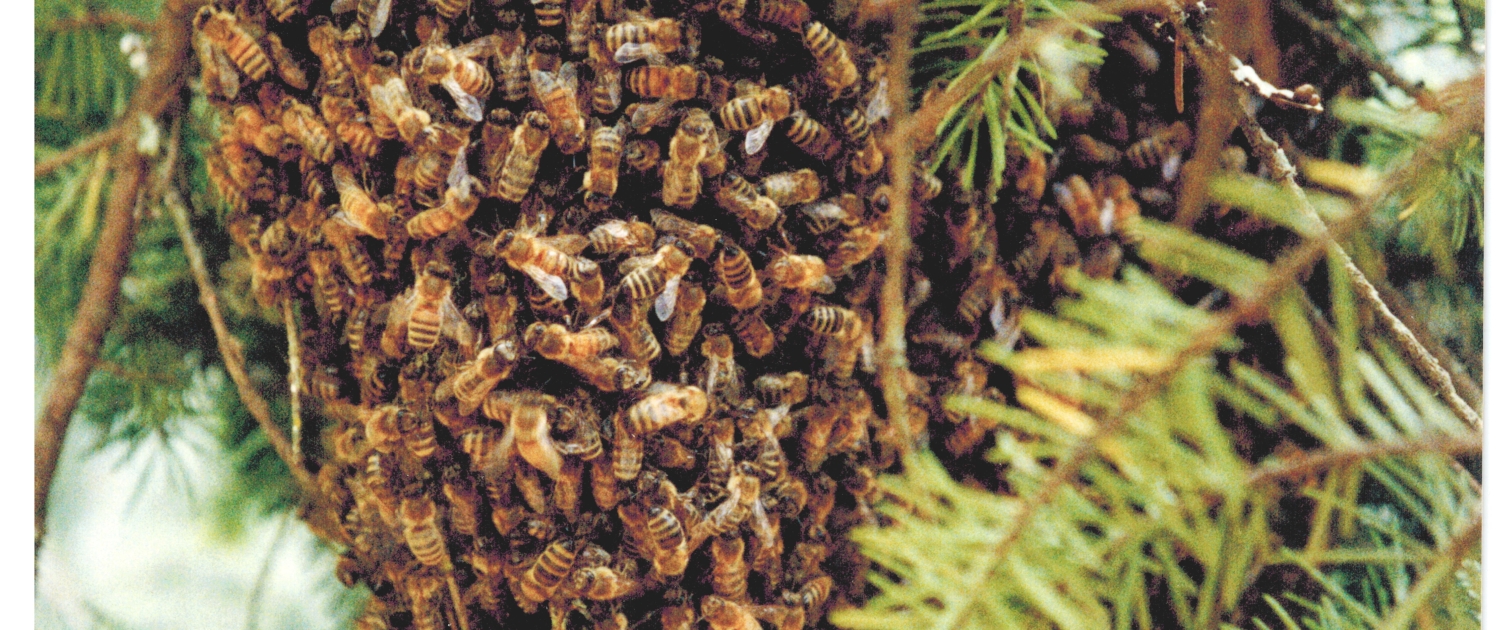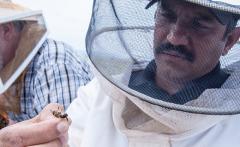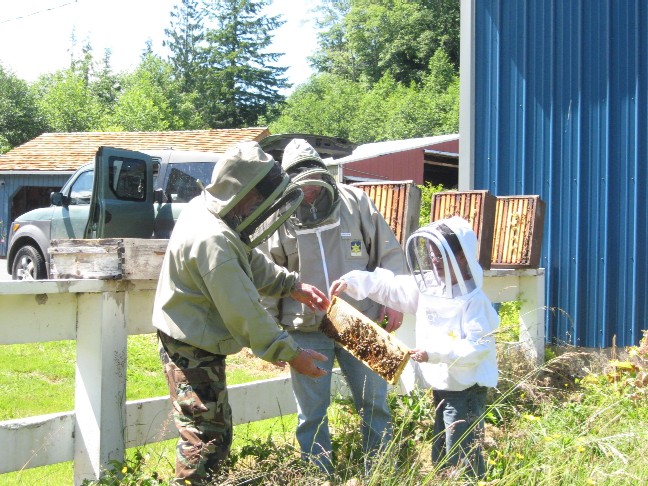What Makes Our Queens Unique…


OWA Checklist for Re queening an Existing Colony
OUR QUEENS HAVE DIFFERENT PHEROMONES, REQUIRING SPECIAL PRECAUTIONS – BEFORE YOUR QUEENS ARRIVE, WE RECOMMEND:
A SPECIAL NOTE IF RE QUEENING IN THE FALL – OR DURING A DEARTH IN NECTAR FLOW: AVOID using feed stimulants containing additives like lemongrass, which can contribute to robbing.
WHEN YOUR QUEENS ARRIVE:
AFTER WAITING THE (6-24) HOURS …FOLLOW THESE STEPS TO INTRODUCE THE NEW QUEEN:
IMPORTANT: RETURN ON THE 4th DAY…
DO NOT DISTURB THE COLONY FOR AN ADDITIONAL 7 DAYS – EARLY DISTURBANCE CAN INCREASE THE RISK OF NON-ACCEPTANCE OR SUPERCEDURE!!!
Because we have been breeding mite and disease tolerant stock for over 22 years, our threshold for unmedicated mite-tolerant genetics is very strict. Late summer is a time we are especially careful to evaluate every hive, with particular attention to potential breeder colonies.
In the fall of 2017 we began to see the presence of some Deformed Wing Virus (DVW) in the apiary. We scrutinized, culled, and prepared our stock to overwinter in much the way we always do, but by early February it became obvious that something was seriously different.
As the populations rapidly dwindled we pulled and incubated queens from the collapsing colonies; then made an emergency March-madness run to California to purchase queenless packages to act as warm-bodies to save the queens.
Although we lost 70% of our colonies over the winter of 2017-2018, by rescuing all the unmedicated queens that had been heavily exposed to DWV, we chose to see this as a new opportunity in our breeding program.
So in June of 2018 when Randy Oliver’s 2016-2017 Overwinter Loss Survey results, from samples submitted in 2016, confirmed that our losses were caused by high infestations of the most lethal strain of DWV-type ”A”, we were not surprised.
We had been here before:
In 2008 we successfully recovered from 90% colony losses due to devastating exposure to n. ceranae. Subsequent lab reports verify that more than a decade later, our hardy survivor stock continues to remain healthy and productive in spite of carrying large n. ceranae spore loads.
…and we believed our proven stock could do it again.
2018 July samples submitted to the USDA Lab as part of the APHIS National Honey Bee Survey, confirmed the continued presence of DWV, but now without obvious symptoms. The unmedicated survivor colonies continued to build-up and thrive … leading us to seek the answer to an important question: Is it possible that survivors of DWV could develop immunity?
In response to that query Jessica Kevill, [Post Graduate researcher for the University of Salford, Manchester England,] replied the following:
It’s hard for me to tell, as DWV is a tricky one. Colonies die once the viral loads exceed the host threshold, whilst colonies which are just below the threshold survive until loads then become unsustainable and they die. Often there are no visible disease symptoms and bees with high loads may not be visibly different to bees with low loads.
If you are interested in resistance, breed from your survivor stock and don’t move bees from outside of the area into your apiary. You will either breed a resistant trait in the bees OR maintain a viral infection that the bees can cope with, we’ve seen this in the UK.
Since we are in a unique situation that allows us to open-mate our queens in relative isolation, the indisputable fact is that our unmedicated recovery stock is not only managing DWV viral loads, but also appear to have succeeded in passing this adaptive trait to their offspring.
To be fair, there is a difference of opinion in the scientific bee community as to whether or not viral exposures can result in “heritable resistance traits” that can be replicated in offspring. We don’t have all the answers. We will leave that debate to the “experts”.
We can only draw conclusions based on lab data results and what we see in the apiary…. and what we see is “survivability”. Our 2019 overwintered survival rate was the best ever, allowing us to sell a record number of spring nucs!
Is this resistance?…tolerance…? Only time will really tell.
Change in ordering policy …
August 2017 – Since most in the rest of Washington State are living with hot dry weather this summer, it may be difficult to imagine the unprecedented conditions we are experiencing here in the microclimate of our apiary.
Persistent smoke from wild fires just across the Straights of Juan de Fuca in British Columbia has pushed a continuous cool/foggy marine layer directly over our isolated mating yards preventing adequate mating conditions here on the North Olympic Peninsula.
In 20 years we have never had to suspend orders due to lack of production, and we deeply regret having to do so now. We could not have predicted these unseasonably adverse weather conditions….check back here later in the season.
No eggs, no larvae does not necessarily mean you are queenless. Here is a simple method to help you know for sure… Shake the bees off of a frame of uncapped brood (eggs and young larvae) from a queen-right colony, being careful not to transfer the queen from that hive. Mark that frame with a magic marker. Remove a frame from the center of the brood chamber of the suspect colony and replace it with your marked frame.
OWA maintains isolated mating yards in a very remote area of the Olympic Peninsula of Washington State. Our drone colonies are selected for hygienic behavior, disease, and mite resistance. They are fed high quality pollen supplements, and are provided with additional drone combs to insure abundant populations.
What our customers have to say …

Swarm
In 1997, when feral colonies were thought to be near extinction due to varroa mites, we began capturing wild honeybee swarms from very remote locations in the sparsely inhabited wilderness of the North Olympic Peninsula of Washington State.
…After decades of selective breeding for Nosema tolerance in the Danish strain, it appears these bees are tolerant to N. ceranae infections.
Today’s microsporidian: nosema is frequently misunderstood, even by experienced beekeepers. The confusion appears to stem from failure to recognize the difference between the 2 types of nosema, and the fact that they manifest themselves within the hive in entirely different ways.
Unlike the favorable conditions found in southern latitudes, Pacific Northwest weather has its own set of unique queen-breeding restrictions: Cool, wet, coastal airflow causes unstable maritime conditions that persist well into late spring. The result is both good news and bad news…
Varroa sensitive hygiene (VSH) is a behavioral trait of honey bees (Apis mellifera) in which bees detect and remove bee pupae that are infested by the parasitic mite Varroa destructor. V. destructor is considered to be the most dangerous pest problem for honey bees worldwide. VSH activity results in significant resistance to the mites.
Minimum of 95% removal of freeze-killed brood in 24 hours
This trait will reduce or eliminate Chalkbrood; AFB; and varroa mite levels w/o the use of chemical treatments
Varroa Mite Resistance
VSH trait is determined by Alcohol Wash Assay during spring brood build-up and fall peak mite infestation.
Grooming Behavior is determined by Alcohol Wash Assay during the winter broodless period
Nosema Tolerance
Demonstrate vigor with high exposure: UNTREATED.
Our selection process is verified by in-house microscopic testing and USDA Laboratory reports.
Hoarding Behavior
Excellent Honey producers
Heavy pollen collectors
Gentleness
No need for gloves
Swarming Behavior
Not prone to swarm
High Degree of Longevity & Solid Brood Patterns
http://www.ars.usda.gov/research/publications/publications.htm?seq_no_115=268796
Research Project: Breeding, Genetics, Stock Improvement and Management of Russian Honey Bees for Mite and Small Hive Beetle Control and Pollination
Location: Honey Bee Breeding, Genetics, and Physiology Research
Title: Patriline variation of Nosema ceranae levels in Russian and Italian honey bees
Authors
BOURGEOIS, LANIE
RINDERER, THOMAS
Sylvester, H
HOLLOWAY, BETH
Submitted to: Cold Spring Harbor Meeting
Publication Type: Abstract
Publication Acceptance Date: April 8, 2011
Publication Date: May 8, 2011
Citation: Bourgeois, A.L., Rinderer, T.E., Sylvester, H.A., Holloway, B.A. 2011. Patriline variation of Nosema ceranae levels in Russian and Italian honey bees. Cold Spring Harbor Meeting. 17.
Technical Abstract: The microsporidian Nosema ceranae has invaded managed honey bee colonies throughout the world. While the presence of N. ceranae is common, infection levels are highly variable, even among bees within a single colony. The underlying mechanisms driving this variation are not well-understood. The high degree of individual variation within a colony suggests some degree of genetic resistance to N. ceranae infections may exist among managed honey bee colonies. One likely source for this variation stems from the polygamous nature of honey bee queens, producing multiple patrilines within each colony. We investigated the relationship between infection levels of N. ceranae and patriline membership by sampling individual bees from colonies from both Russian and Italian stocks. A total of 720 bees were collected from 5 Russian and 5 Italian colonies. Individual bees were tested for N. ceranae infection levels using qPCR, and were genotyped to determine patriline membership. Levels of N. ceranae varied significantly at the stock level (Russian: 3.68 x 106 ± 1.88 x 106 nosema/bee and Italian: 9.14 x 106 ± 4.62 x 106 nosema/bee; P = 0.008) and at the colony level for both Russian (P = 0.002) and Italian (P = 0.003) bees. Patriline-based variance was evident among only the Russian bees (P = 0.024). There was substantial variation in N. ceranae levels among Italian bees, ranging from 0 to 2.12 x 109 nosema/bee, however this variation was not associated with patriline membership (P = 0.742). The variance in N. ceranae infection among Russian honey bee patrilines demonstrates a genetic basis for resistance to N. ceranae infection which conforms to predictions of models that relate patriline variance and abundance to disease resistance in honey bees. This difference between Russian and Italian honey bees may derive from Italian honey bees having only a short history of exposure to N. ceranae while Russian honey bees may have had 150 years of exposure.
Last Modified: 02/05/2012
 Bee researcher Ramesh Sagili inspects a European honey bee in a carrot seed field near Madras, Ore. Photo by Lynn Ketchum
Bee researcher Ramesh Sagili inspects a European honey bee in a carrot seed field near Madras, Ore. Photo by Lynn KetchumThe finding, published recently in the Journal of Insect Physiology, suggests that giving honey bees access to a greater quantity and variety of pollen—their only source of protein—could make them more resilient against parasites and other pests, and help to stem worrisome declines in bee populations.
PENINSULA DAILY NEWS
 Three generations of beekeepers
Three generations of beekeepersHistory of OWA Russian Honeybees
NEXT UP, THE SURVIVORS
Part two of two parts. by M.E.A. McNeil